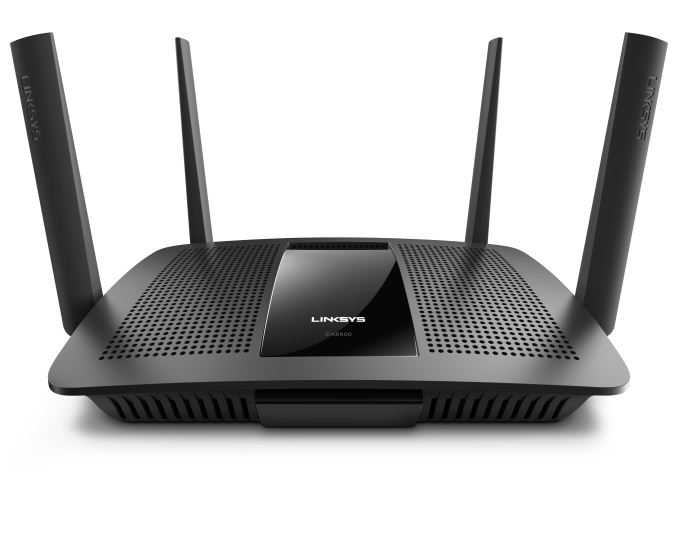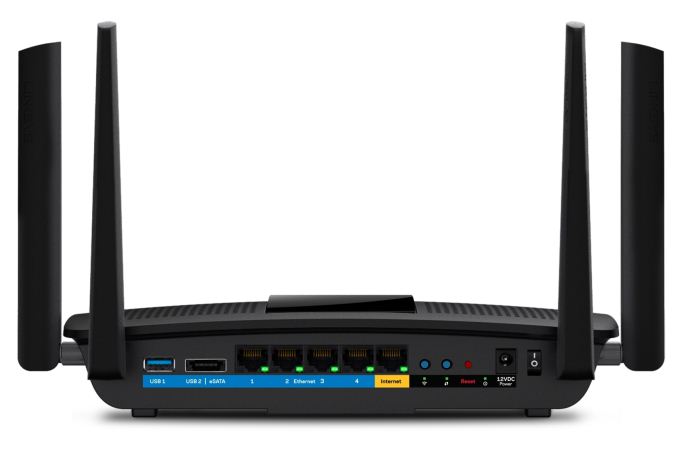Linksys EA8500 - First MU-MIMO Enabled 802.11ac Router Set to Ship
by Ganesh T S on May 7, 2015 7:00 AM EST- Posted in
- Networking
- Linksys
- 802.11ac
- Wi-Fi
- Qualcomm Atheros

Readers following our wireless networking coverage must be quite familiar with the developments in 802.11ac land. As a recap:
- The first 3-stream 802.11ac routers (based on the Broadcom BCM4706 chipset) started shipping in May 2012, with Buffalo Technologies and Netgear leading the way. There were marketed as AC1750 units (3x3 5 GHz providing up to 1300 Mbps and 3x3 2.4 GHz providing up to 450 Mbps). The street pricing of the AC1750 routers started to go down once Qualcomm started shipping their first-generation 802.11ac router platforms in products such as the TP-LINK Archer C7 in April 2013.
- In Q4 2013, a wave of AC1900 units started to hit the market. Netgear's Nighthawk R7000, a popular member in this series, still continues to sell well in the market. These units still used a 3x3 5 GHz radio for up to 1300 Mbps, but the 2.4 GHz had some proprietary Broadcom extensions (TurboQAM) to support up to 600 Mbps in an end-to-end Broadcom environment.
- In 2014, Quantenna began to bring their technology lead in the Wi-Fi space to the market with their Wave 2 4x4 802.11ac chipset. Despite being announced at CES 2014, the Asus RT-AC87U began to ship in July with the QSR1000 radio coupled with a Broadcom SoC. Netgear started to ship the same radio coupled with a Qualcomm IPQ8064 SoC in the Nighthawk X4 in September 2014. The QSR1000's Wave 2 feature set includes support for MU-MIMO, but neither of these routers shipped with MU-MIMO enabled in the firmware (citing lack of client support at that point of time). Given the 4x4 configuration, these routers were tagged as AC2350 / AC2400 units (600 Mbps in the 2.4 GHz band and 1733 Mbps in the 5 GHz band)
- In the midst of these Wave 2 product launches, Qualcomm announced plans for their Wave 2 802.11ac platforms (both routers and clients) in April 2014. Broadcom, being late to the Wave 2 party, decided to bring out the XStream platform with dual 5 GHz radios (six-stream configuration) also in April. They were able to get it quickly into the market too, with the Netgear Nighthawk X6 R8000 becoming available in June 2014.
- At CES 2015, we saw the first set of routers based on Qualcomm's QCA9880 4x4 Wave 2 802.11ac router platform getting announced. Vendors such as TP-LINK and TRENDnet were expecting their AC2600 class routers to ship towards the middle of the year.
Coming back to today's announcement regarding the EA8500, Linksys is becoming the first vendor to start shipping a QCA9980-based router. The important aspect here is that the router will ship with MU-MIMO enabled. Client devices with MU-MIMO enabled are also coming into the market just now (more on that in our detailed review). Hopefully, this announcement will spur both Netgear and Asus to enable MU-MIMO in the firmware for their Quantenna-based routers.
The salient features of the EA8500 router are listed below:
- 4x4 802.11ac with MU-MIMO and beamforming support
- QCA9980 radio + 1.4 GHz dual-core IPQ8064 SoC
- Simultaneous dual-band operation (5 GHz 802.11ac - 1733 Mbps, 5 GHz 802.11n - 600 Mbps, 2.4 GHz 802.11n - 800 Mbps)
- 1x USB 3.0, 1x USB 2.0 / eSATA
- 4x 1Gbps LAN, 1x 1Gbps WAN
- Adjustable antennas for optimal performance
One important point to note is that MU-MIMO capabilities will translate into real benefit only when there are multiple MU-MIMO-capable client devices talking to the router simultaneously. This will probably be a common scenario in enterprise Wi-Fi deployments soon. However, in a typical household, we would imagine that a situation involving multiple MU-MIMO clients is probably at least a good year away. Qualcomm is targeting an end-to-end play here, as the announcement made last year included a number of products in the client space with MU-MIMO capabilities.
Linksys is accepting pre-orders at $280 for the EA8500 today with shipments slated for May 10, 2015. Wide retail and e-tail availability is also expected starting next week. There is no doubt that MU-MIMO will be the most efficient way to boost Wi-Fi performance in the near future, and it is good that Linksys and Qualcomm are teaming together to accelerate its market adoption.
Source: Linksys











83 Comments
View All Comments
extide - Thursday, May 7, 2015 - link
Yeah, I have had some Ubiquity gear in the past, it's always been quite good, but as mentioned, nothing with the latest gen chipsets yet. Oh well, will have to see what come out.9th - Saturday, May 9, 2015 - link
i've tried huawei, tp-link, linksys and d-link routers before as access points by disabling DHCP for my home wifi solution over last four and half years. then i tried mikrotik and have been really satisfied since.OTOH my office uses ubiquiti, their software interface is nice and we never faced signal issues with them. but they are expensive for home/personal use IMO.
UtilityMax - Tuesday, May 12, 2015 - link
Any router faster than AC1750 standard is a waste of money. (3x3 streams at 5GHz, and 3x3 at 2.4GHz). In fact, arguably, since most high end PCs come only with 2x2 adapter, you might as well get an AC1200 or AC1300 router. Any router supporting standards higher than AC1750 or AC1900 is much faster than what typical client hardware supports, and the only way to go beyond that is to use MU-MIMO (like this router supports), but there is still no client support for MU-MIMO at all. So I'd personally get a cheap AC1200 router, like tp-link C5, use for a couple of years, then buy a higher end machinery once MU-MIMO clients become common.Take a look at smallnetbuilder.
knightspawn1138 - Thursday, May 7, 2015 - link
I don't trust a Linksys router any further than I can throw one. Even that's a bit too far. I wasted over an hour on the phone with their tech support and all they kept doing was making me clone my mac address to the stupid router. Turns out their router had a WAN port that was too stupid to get an IP address.Zak - Thursday, May 7, 2015 - link
I'll be more excited about an affordable 10gigabit home switch and interfaces:(sonicmerlin - Thursday, May 7, 2015 - link
Why are they allowed to market these as "1700 mbps" when even in ideal conditions you won't get more than half that?extide - Thursday, May 7, 2015 - link
That's the PHY rate, ALL networking gear has ALWAYS been advertised based on the PHY rate.sonicmerlin - Friday, May 8, 2015 - link
But that strikes me as really misleading. The average consumer sees "1700 Mbps" and they think that's the speed they'll get. PHY rate is utterly irrelevant to them.UtilityMax - Tuesday, May 12, 2015 - link
Duh, let me tell you that 90% of all wireless marketing is utter scam. Just recall how they advertized Wireless-N being capable of 300Mbit on each band while in reality, most consumer devices, even high end PCs end up coming with a neutered single stream 2.4GHz-only single-band wireless-n card, giving you about 20% improvement over the old G-standard, and link rate about four times less than the adverized N300, or N600, even at PHY rate.UtilityMax - Tuesday, May 12, 2015 - link
Arguably, you won't even get a half of that. The highest end PCs come with a 3x3 wireless AC card, which maxes out at "1300mbit", but in reality you get like a third of what's advertized. The advantage of the MU-MIMO router like this one, is that now you can have two clients talking to the router simultaneously, splitting the four streams between themselves, two to each, and that is arguably an improvement. The only issue is that there is no MU-MIMO client hardware on the market right now. Personally, I'd keep the current routers, then buy a MU-MIMO router like two years from now, when their price will be half of the current.